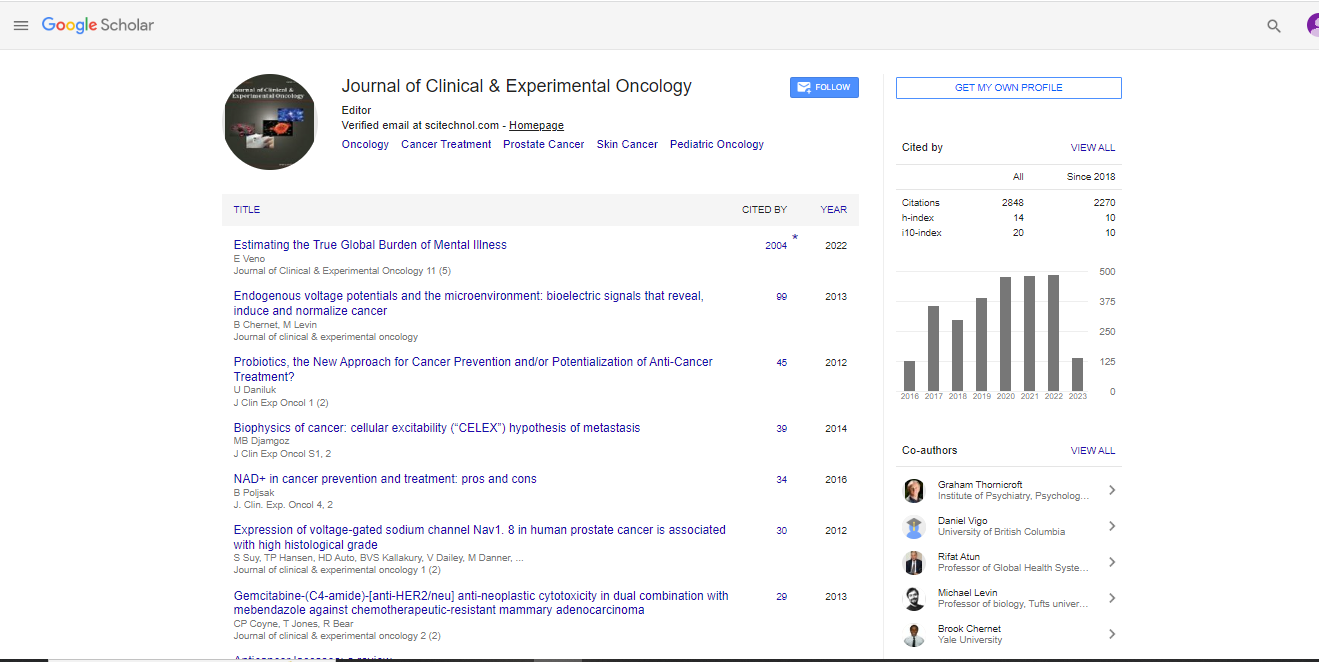Opinion Article, J Clin Exp Onco Vol: 12 Issue: 3
Evaluating Types and Effects of Lung Cancer on Health
Kwang Andrea*
1Department of Thoracic Surgery, Northwestern University, Chicago, United States of America
*Corresponding Author: Kwang Andrea,
Department of Thoracic Surgery,
Northwestern University, Chicago, United States of America
E-mail:Kwang_andrea@nu44.edu
Received date: 23 May, 2023, Manuscript No. JCEOG -23-104756;
Editor assigned date: 25 May, 2023, PreQC No. JCEOG-23-104756 (PQ);
Reviewed date: 08 June, 2023, QC No. JCEOG-23-104756;
Revised date: 15 June, 2023, Manuscript No. JCEOG-23-104756 (R);
Published date: 22 June, 2023, DOI: 10.4172/2324-9110.1000354.
Citation: Andrea K (2023) Evaluating Types and Effects of Lung Cancer on Health. J Clin Exp Oncol 12:3.
Description
Lung cancer remains a significant global health concern, affecting millions of individuals and presenting various types with distinct characteristics. By understanding the different forms of lung cancer and their impacts, one can enhance awareness, early detection, and treatment strategies. Recognising the multifaceted effects of lung cancer is essential for healthcare professionals, policymakers, and individuals impacted by the disease.
Lung cancer can be broadly categorized into two primary types. Non-Small Cell Lung Cancer (NSCLC) and Small Cell Lung Cancer (SCLC). NSCLC accounts for approximately 85% of all lung cancer cases and includes subtypes such as adenocarcinoma, squamous cell carcinoma, and large cell carcinoma. Each subtype has distinct characteristics in terms of cell origin, growth patterns, and treatment response. Non-Small Cell Lung Cancer (NSCLC) accounts for approximately 85% of all lung cancer cases and encompasses multiple subtypes, including adenocarcinoma, squamous cell carcinoma, and large cell carcinoma. Adenocarcinoma is the most common subtype of NSCLC and primarily arises in the outer regions of the lungs. It is associated with various risk factors, including smoking and exposure to environmental pollutants. Adenocarcinoma tends to grow more slowly than other subtypes and can present as a solitary nodule or develop into invasive tumors.
Squamous cell carcinoma typically arises in the central airways of the lungs. It is often linked to smoking and can manifest as a mass obstructing the bronchus. This subtype is more likely to cause symptoms such as coughing up blood and hoarseness. Large cell carcinoma represents a heterogeneous group of tumors that lack the specific features of adenocarcinoma and squamous cell carcinoma. It tends to grow rapidly and can occur in any part of the lung.
SCLC, on the other hand, represents about 15% of lung cancer cases and is characterised by rapidly dividing small cells. SCLC tends to be more invasive and has a higher propensity for metastasis compared to NSCLC. Several risk factors contribute to the development of lung cancer. The most significant cause is tobacco smoking, which accounts for the majority of cases. Exposure to secondhand smoke, occupational hazards such as asbestos and radon, air pollution, and genetic predisposition are also associated with increased lung cancer risk. The effects of lung cancer on health are substantial and far-reaching. As the disease progresses, it can cause a range of symptoms such as persistent coughing, shortness of breath, chest pain, unintended weight loss, fatigue, and recurrent respiratory infections. These symptoms can significantly impact an individual's quality of life, physical functioning, and overall well-being.
Lung cancer can also lead to various complications, including pleural effusion (the accumulation of fluid around the lungs), pneumonia, respiratory failure, and superior vena cava syndrome. Metastasis to other organs such as the liver, bones, brain, or adrenal glands further exacerbates the health effects and prognosis. The psychological and emotional impact of lung cancer should not be overlooked. A diagnosis of lung cancer often elicits fear, anxiety, depression, and feelings of uncertainty. Treatment modalities such as surgery, chemotherapy, radiation therapy, or targeted therapies may result in side effects including nausea, hair loss, fatigue, and immune suppression, further impacting the overall well-being of individuals.
Conclusion
Lung cancer, which encompasses various types, poses significant effects on health and quality of life. Understanding the different forms of lung cancer, their causes, and associated risks is important for effective prevention, early detection, and treatment. The multifaceted impact of lung cancer on individuals necessitates comprehensive support systems, including medical care, psychological support, and resources for patients and their families. By raising awareness and implementing preventive measures, one can strive to reduce the burden of lung cancer, improve patient outcomes, and enhance the overall well-being of those affected by this challenging disease.
 Spanish
Spanish  Chinese
Chinese  Russian
Russian  German
German  French
French  Japanese
Japanese  Portuguese
Portuguese  Hindi
Hindi 



